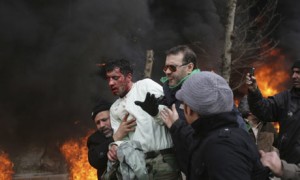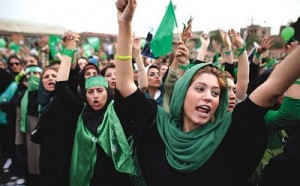 One of the main questions of the international political community at this moment seems to be: how can we stop Iran from obtaining nuclear weapons? One approach aims to ‘change the behavior’ of Tehran by using the containment-doctrine,which for example had sought a balance of power between Iran and Iraq in order to contain whichever nation seemed to present the greatest threat at the time. The other option is the ‘always on the table’ approach, and refers to the threat of (pre-emptive) military action, intending to menace Iranian strategists to adjust their calculations. In diplomatic terms, it is called the stick-and-carrot approach: punish them for ‘bad’ behavior and reward them for ‘good’ behavior.
One of the main questions of the international political community at this moment seems to be: how can we stop Iran from obtaining nuclear weapons? One approach aims to ‘change the behavior’ of Tehran by using the containment-doctrine,which for example had sought a balance of power between Iran and Iraq in order to contain whichever nation seemed to present the greatest threat at the time. The other option is the ‘always on the table’ approach, and refers to the threat of (pre-emptive) military action, intending to menace Iranian strategists to adjust their calculations. In diplomatic terms, it is called the stick-and-carrot approach: punish them for ‘bad’ behavior and reward them for ‘good’ behavior.The threat from Iran is not only its nuclear program, or its consequent support for terrorism, but also the ambition of the government to export its Islamic revolution to the world, institutionalized in article 2 of its Constitution. Due to their lack of understanding and empathy with Iranian decision makers, many Western countries assume that the Islamic leaders of Iran act rationally. However, this may not always be the case.
I. Nuclear Program of Iran has Mislead the West
Western countries think that the Iranian decision makers can be restrained with constant and endless-dialogues, threatening them with sanctions or a military action. In addition, they think that the nuclear issue has a central priority for Iranian decision makers, as it does for the West. That is not the case. The main concern of the Islamic leaders right now is not the national sovereignty and interests of Iran, but their own political agenda to stay in power. According to article 176 of Iran’s Constitution, the Supreme Leader has the last word with regard to “preserving the Islamic Revolution, territorial integrity, and national sovereignty.” For the Supreme Leader, national sovereignty does not exist. Instead, “sovereignty and divine laws” reside uniquely in Allah. Depriving a nation of its rights to sovereignty and making it “godly” means withdrawing from a nation its right to self-determination. In this case, the branches of government derive their power not from the people, but from God.
Iran’s military power is not its conventional military capability but its unique capacity to manage an asymmetric proxy-war far from its own border. Iran facilitates and indirectly commands the militaries of Hizballah (Libanon), Hamas (Palestina), Al-Mahdi (Iraq) and Shia’s at the Yemen-Saudi border. Iran’s regional supremacy is not a result of its conventional military power, but its capability to supervise these proxies and motivate them to start small-scale proxy hostilities, such as the 33 days war between Hizballah and Israel in 2006. That is the reason why an atomic bomb does not make Iran more powerful militarily – since Israel and Pakistan are nuclear already – but it gives Tehran a perfect rhetorical over-confidence to export its Islamic Revolution in the region and later on in the world.
Pretending that the nuclear ambition is Iran’s first priority has been the most successful strategy of Tehran of the past 10 years. By doing so, Tehran institutionalized a major misinformation to its real and substantial threat (power of the people) in the shadow of becoming nuclear.
II. Countering ‘Soft’ War – Government’s main priority
A structural analysis of statements made by the highest political power Ayatollah Khamenei, especially after the internal polarization caused by the tumult around the presidential election last summer, gave insight into the real political substances of the government. In a meeting with the members of the Basij Resistance Force, Khamenei underlined that Iran’s main priority is to counter the enemies’ ‘soft war’. He delineated the aspects of this war and stated: “in a soft war, the enemy tries to make use of advanced cultural and communication tools to create suspicion and discord among people.” Then he referred to the post-election events in the country as an example of this method. The terms ‘soft war’ or ‘cultural NATO’ refers to the archenemy of the Islamic Republic: the principles of liberal democracy and secularism disseminated implicitly by the West.
Earlier that week Ali Jafari the highest General of the Revolution Corps (IRGC) stressed that uprising of the people is “the primary menace” for the regime and Islamic Revolution in the last 30 years. He qualified it further and said that “these fitna (enemy’s conspiracies) are even more dangerous’ than the Iran-Iraq war (1980-1988), a ‘hard war’ which cost more than a million lives. Both Khamenei and Jafari, as the two highest officials in Iran at the moment, are unanimous about the impacts of the ‘soft war’ and consider confronting it as “the most important need of the Islamic ruling system”.
III. Iran’s Worst Enemy: Liberal Democracy and Secularism
The conclusion is evident: the greatest weakness of the Iranian government is not a threat of economic sanctions or even military action, but the elements of Western liberal democracy, which target the very existence of the Islamic regime. This concept, along with secularism, is the worst and most frightening enemy of Iran. This is the strongest weapon of the West against Iran and exactly the key to restraining the Islamic leaders of Iran.
III. 1 Strong Middle-Class
One of the first conditions to a liberal democracy is an educated middle-class hungering for their democratic rights. A proviso to that, in the case of theocratic and totalitarian regime of Iran, is secularism where state and Islam are separated. The middle-class of Iran hungers for self-determination and liberal democracy. This middle-class is growing due to urbanization. 75% of the 70 million Iranians live in the cities. There is an explosive growth of information flow (35% of the people have access to the Internet, almost 20 million mobile phones and more than half of the population has access to satellite televisions). Literacy is expanding (85%), along with the thirst for knowledge, which leads to a perfect breeding ground for the most important condition against the Iranian ideological and totalitarian regime: political development.
III. 2 Students & Women
An increasing number of the youth (70% of the population is younger than 35 years old) are well educated and have more affinity with the modern way of life than the Regime’s prescription. There is a strong Women’s right movement which is at the forefront of protests in the country, demanding more rights and equality for all citizens.
In a country such as Iran where political parties do not exist and free media is hardly present, the young educated elite plays a very decisive role as the vehicle of the avant-garde movement. As students were crucial in the Velvet revolution of Yugoslavia in the 90’s and the Color Revolution in the Balkan at begin of 21th millennium, we see similarities reflected in the Iranian Student Day demonstration on 7th of December 2009.
On this day, many students fearlessly demonstrated against the regime and chanted: “Khamenei is a murderer, his leadership is invalid”. By that chant, they attacked the heart of the Islamic Republic of Iran. Student Day is traditionally an anti-US event that commemorates the killing of three students during the Pahlavi-era in 1953. Nevertheless, the students hijacked this official protest by chanting their own anti-government slogans. They went even further and ripped pictures of Ayatollah Khomeini, the founding father of present Islamic government. By doing so, they declared a clear message to the world: We do not want an Islamic regime anymore! Those who were intended to have a fundamental role in ‘ensuring the uninterrupted process of the revolution of Islam’ (Article 2 Constitution19) now call their leader an ‘illegitimate slayer’.
Western countries reacted with surprise when the stable autocratic regime of the Pahlavi-dynasty crumbled down thirty years ago. Thirty years later, they are again surprised about the continuous protestors who chant almost the same slogans as then: Esteghlal, Azadi, Jomhouri Irani; ‘Independence, Freedom and Iranian Republic’, instead of Jomhouri Islami meaning ‘Islamic Republic’ of Iran.
That is the reason for the Supreme Leader’s concern about the real peril of his regime. This was visible at the start of the 2009 school year. Khamenei said that 2 million of the total 3.5 million students who study Humanities and Social Sciences are ‘a source of great worry’. He added that education of these social sciences at the universities ‘‘induces disbelief” in celestial and Islamic culture.
IV. Government’s solution: Islamisation of Sciences
The supposed reason for Khamenei’s assertion that social sciences induce disbelief in Islamic culture, is that the sciences are based on Western materialistic (humanistic and secular) philosophy and studying at the universities causes doubt, suspicion and discord in the fundamental grounds of the Islamic system and the revolution. This analysis provides the ideological establishment of a soft combat with another enemy: Humanities and Social Sciences. The suppression of humanities and social sciences happened during the Cultural Revolution in 1980, so they believe they can do it again. However, the Iranian attempt at a second Cultural Revolution that aims to Islamize education and Humanities and Social Sciences is a useless effort, because unlike Islam, science is not a religion that can be ideologised.
Meanwhile many policies have been made. Several lecturers in Humanities and Social Sciences have been purged and discharged from the universities, and books have been rewritten with elimination of the ancient history of Persian Kingdom-dynasty, which makes place for Islamic history. Clerics are being appointed in all schools to impart religious values, and to propagate a culture of “altruism and martyrdom’’. In the end, this project will fail because eliminating or restricting Humanities and Social Sciences will not limit questioning and rebellion in the name of political ideologies
Conclusion
Advanced communication technologies, especially the Internet and its democratic power to make information accessible, make it possible to stay connected with everyone in the world. Through mediums of dialogue, such as the internet, young Iranians obtain knowledge about the institutionalized liberal democratic values of the West. In time, it will lead to adaptation of these values that could incrementally establish a democratic Iran. This new generation of liberal democrats would perceive the institutionalization of their values as their main objective, raising that priority higher than Iran’s nuclear program. Due to this development, the threat of a nuclear Iran would diminish.
The solution is right under our nose, yet we are searching far and wide for it. As a Persian mystical poet Rumi said it wisely in the 13th-century: Ab dar kooze O Ma Teshne laban migardim, Water is in the jug, yet we are wandering around with parched lips.
By Damon Golriz
[nggallery id=24]



Lascia un commento